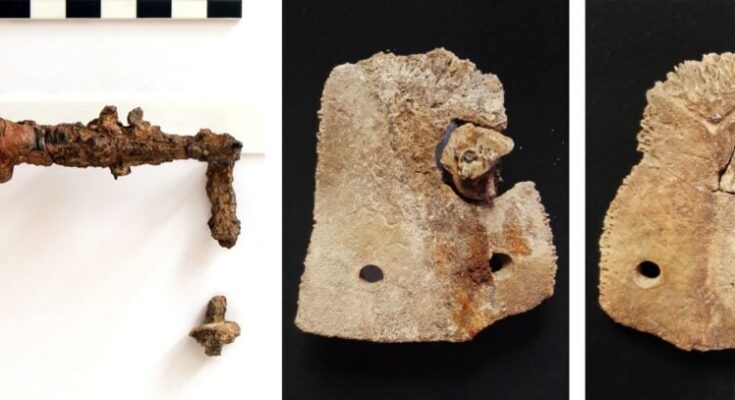
The lyre was the musical instrument that accompanied the education and entertainment of children and teenagers in Ancient Greece.
Apollo, the god of music, played the divine instrument and gave Orpheus a golden lyre as a gift and taught him to play it. Orpheus became a legendary lyre player and had a magical singing voice.
In 2007, in the Athens area of Kerameikos, archaeologists unearthed the burial of a teenager who lived in the 5th century BC. Among the rich burial gifts was an eel-like lyre, presumably signifying that the boy was playing the lyre.
According to the Athens-Macedonian News Agency report, the burial of the 10-13-year-old boy who lived around 470-450 BC was found between the Irian Pyles and the Dipylon, in the area of Kerameikos. Salvaged from the musical instrument were 74 sections of the tortoise shell resonator and nine sections of the iron chordotone, the metal part to which the strings were attached.
“The discovery of parts of musical instruments, much more intact ones, in excavations is extremely rare due to the increased vulnerability of their construction materials,” Vasiliki Mylona, conservator of antiquities of the Ephorate of Antiquities of the City of Athens, said.
The lyre, Mylona said, had an adventurous journey through time: “Ancient musical instruments were primarily made from organic materials such as wood, horn, bone, leather, membranes of animal origin, etc. The above materials wear out easily and quickly in most types of burial environment ”
Fluctuations in humidity and temperature, the acidity or alkalinity of the burial environment, the interaction with nearby different construction materials, are just some of the parameters that affect the course of deterioration of organic materials during their burial,” the conservator added.
A significant find
It took significant effort to save the precious 2,500-year-old ancient Greek lyra and it was done in stages. From its detachment and transfer from the excavation sited to the preservation workshop in a block burial environment until its removal by the team of conservators of the Ephorate of Antiquities of the City of Athens.
Musicologist of ancient music Stelios Psaroudakis, assistant professor of Ancient Greek Music at the department of music studies in the National Kapodistrian University of Athens recognized its importance and collaborated with the conservators.
Special care was given to the burial of the ancient Athenian teenager as it housed a remarkable number of offerings: A flute, a lyre resonator and a chordotone stood out. In addition to the musical instruments, two black lekythos, a white lekythos, a clay alabaster of the 5th century BC and an iron strigil were found. Strigils were common in male burials from the classical era onwards, signifying that the deceased was an athlete.
Archaeologist Antonia Kokoliou who spoke to AMNA, said that, “The most special decoration is the resonator of the lyre, which suggests the existence of a strong relationship between social class and the hope that connects the Underworld with musical instruments. Also, according to Aristotle, the lyre holds a high place between life and death.”
And she continues: “According to (Swedish poet and expert on ancient Greek poetics) Jasper Svenbro, the lyre is the only instrument that allows the souls of the dead to return to the world of the living.”
The burial was emotionally charged
The archaeologist noted that the burial ceremony was carried out with great emotional charge by those who prepared it. “The objects had been carefully placed on the boy’s grave by those close to him and reflect their expectations that death had crushed. Lyres, in addition to conveying an element of luxury, also convey the image of social life and are presented to the wider community.
“For ancient Greeks, music contributed exclusively to the education of the soul, while gymnastics to the education of the body… The musical instruments are placed on the grave signifying that the children will never go through the stages of social life, of adulthood, of husband or father, and above all of venerable Athenian,” Kokoliou noted.
Since the burial is located in Kerameikos, archaeologists believe it is part of a large cemetery. Nearby is a courtyard of a temple, a sanctuary dedicated to Artemis. She was the chthonian goddess of fertility, protector of childbirth and the wild world, who undertakes the raising all the little ones.
In the same cemetery, a second grave of a child about 4-years-old was found with 36 offerings, as well as a second resonator of a small lyre. The tomb dates back to around the middle of the 5th century BC.
Conservation of the ancient Greek lyra
Maintaining the musical instrument was not an easy task, starting from the secondment stage. “The horn sections of the ancient lyre resonator were located at different depths and detached from the ground together with a volume of soil reinforced with plaster strips. A plaster mold was constructed around the soil mass for the safe transport of the whole to the conservation laboratory.”
The next challenge was the removal of the hard solid layer of soil and salts from the keratin plates, which were fragile and had a tendency to peel off, degradation, shrinkage, deformation, flattening, or be attacked by microorganisms. The iron parts of the ancient instrument were severely corroded.
Conservators used optical microscope and mechanical means along the application of a solution of mild organic solvents. The cleaning process was particularly time-consuming and laborious and was the most demanding part of the preservation of the precious find.
Cleaning was followed by fixing work – to hold the tiny flakes of material, to strengthen the fragile areas and cracks – as well as to weld the broken parts and shrink the material. Cleaning of the iron corrosion products, welding and surface protection were carried out on the string tone.
Antiquity conservators detached the precious lyre from the excavation field and carried out the conservation of three parts of the chordotone. They decided not to fill in the missing parts of the ancient musical instrument with modern materials such as epoxy resins, for reasons of conservation ethics.
“The strings of ancient stringed musical instruments, such as the various types of lyre, the guitar, the harp, were made from animal gut or tendons, according to surviving written sources,” Mylona said.
“In the case of the lyre, careful observation of the central part of the chord under the microscope revealed to us the presence of a tiny narrow strip, encased in a layer of corrosion products. We hypothesized that this is a tiny piece of intestinal chorda, which was preserved on the surface of the iron chordotone due to the diffusion of iron corrosion products into its organic structure.”



